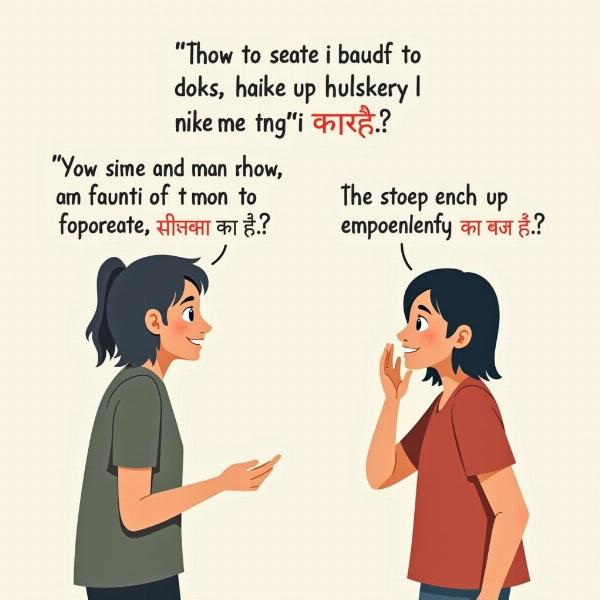Understanding how to express “same situation” in Hindi can be crucial for effective communication. Whether you’re discussing shared experiences, comparing circumstances, or simply acknowledging similarities, knowing the appropriate Hindi phrases can significantly enhance your interactions. This article delves into various ways to convey “same situation meaning in Hindi,” providing you with a comprehensive understanding of the nuances and cultural contexts.
Different Ways to Say “Same Situation” in Hindi
There isn’t one single perfect translation for “same situation” in Hindi. The best choice depends on the specific context and the nuance you want to convey. Here are some common options:
- एक जैसी स्थिति (Ek jaisi sthiti): This is a literal translation, meaning “one kind of situation.” It’s a straightforward way to express similarity.
- समान परिस्थिति (Saman paristhiti): “Saman” means similar or equal, while “paristhiti” means situation or circumstance. This option emphasizes the equality of the situations.
- वही हालत (Wahi haalat): This translates to “the same condition” or “the same state.” It often implies a difficult or challenging situation.
- ऐसा ही हाल (Aisa hi haal): Meaning “similar condition,” this is a more colloquial way to express the idea of a shared experience.
- बिल्कुल वैसा ही (Bilkul waisa hi): This translates to “exactly the same” and emphasizes the identical nature of the situations.
 Two people discussing similar experiences in Hindi
Two people discussing similar experiences in Hindi
Choosing the Right Phrase
The specific context determines which phrase is most appropriate. For formal settings, “Saman paristhiti” or “Ek jaisi sthiti” are suitable choices. In informal conversations, “Wahi haalat” or “Aisa hi haal” might feel more natural. If you want to emphasize the identical nature of the situations, “Bilkul waisa hi” is the best option.
How do you express “being in the same boat” in Hindi?
To express the idiom “being in the same boat,” you could use phrases like “एक ही नाव में (ek hi naav mein)” which literally translates to “in the same boat” or “समान स्थिति में (saman sthiti mein)” meaning “in a similar situation.”
Can you give examples of how to use these phrases in sentences?
- Formal: “हमारी कंपनी भी समान परिस्थिति का सामना कर रही है (Hamari company bhi saman paristhiti ka samna kar rahi hai)” – Our company is also facing a similar situation.
- Informal: “यार, मेरा भी वही हाल है (Yaar, mera bhi wahi haal hai)” – Man, I’m in the same boat.
- Emphasis on identicality: “उसकी कहानी बिल्कुल वैसी ही थी जैसी मेरी (Uski kahani bilkul waisi hi thi jaisi meri)” – His story was exactly the same as mine.
Understanding Cultural Nuances
Indian culture emphasizes empathy and shared experiences. Using phrases that acknowledge similar situations can build rapport and demonstrate understanding. Being mindful of the context and choosing the appropriate phrase shows respect and strengthens communication.
Dr. Anjali Sharma, a linguist specializing in Hindi, says, “Choosing the right phrase to express ‘same situation’ demonstrates cultural sensitivity and enhances communication. It’s about understanding the nuances of the language and its connection to Indian values.”
Conclusion
Effectively communicating the idea of “same situation meaning in Hindi” involves understanding various phrases and their subtle differences. By choosing the right words, you can navigate different social contexts and build stronger connections with Hindi speakers. Remember to consider the formality of the situation, the specific nuance you want to convey, and the cultural context to ensure clear and respectful communication.
FAQ
- What is the most common way to say “same situation” in Hindi? “Ek jaisi sthiti” is a common and versatile option.
- How do you say “we are in the same boat” in a formal setting? “Hum bhi saman paristhiti mein hain” is a suitable formal expression.
- Is there a difference between “haalat” and “sthiti”? While both mean “situation,” “haalat” often implies a more difficult circumstance.
- How can I improve my understanding of Hindi idioms? Immersing yourself in Hindi media and interacting with native speakers can help.
- Why is it important to understand cultural nuances in language? Cultural nuances contribute to effective and respectful communication.
- Where can I find more resources for learning Hindi? Numerous online resources, language learning apps, and books are available.
- How do I choose the right phrase for a specific context? Consider the formality of the situation and the specific meaning you want to convey.
Related Articles
- braveheart meaning in hindi
- work order meaning in hindi
- what about you in hindi meaning
- we will meet tomorrow meaning in hindi
Meaning-Hindi.in is your premier destination for professional Hindi translation services. We specialize in business, legal, technical, website localization, educational, and urgent translations, ensuring accuracy and cultural sensitivity. Our team of expert linguists is dedicated to providing high-quality translations that bridge language barriers and facilitate effective communication. Need a document translated quickly and accurately? Contact us at [email protected] or call us at +91 11-4502-7584. Meaning-Hindi.in is here to help you connect with the world through the power of language.